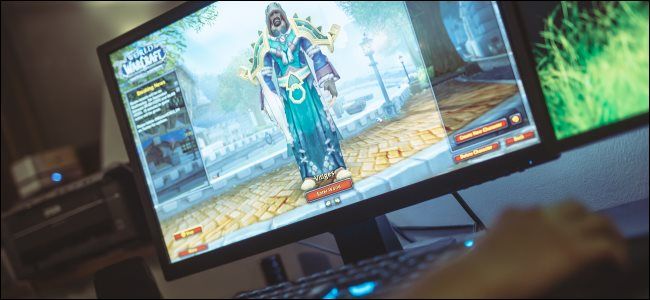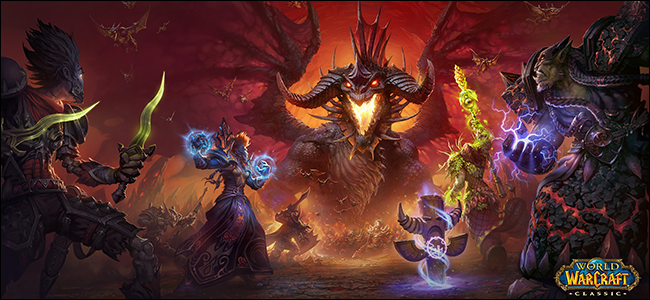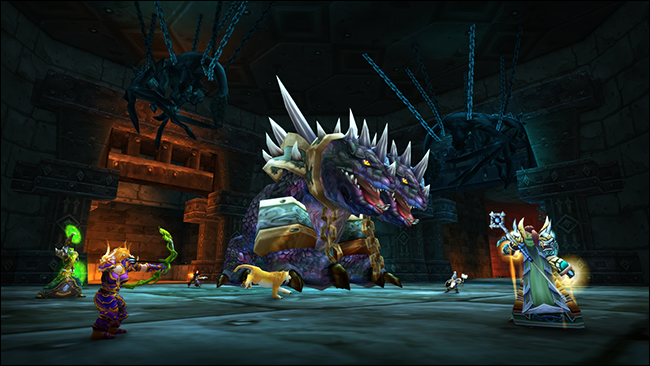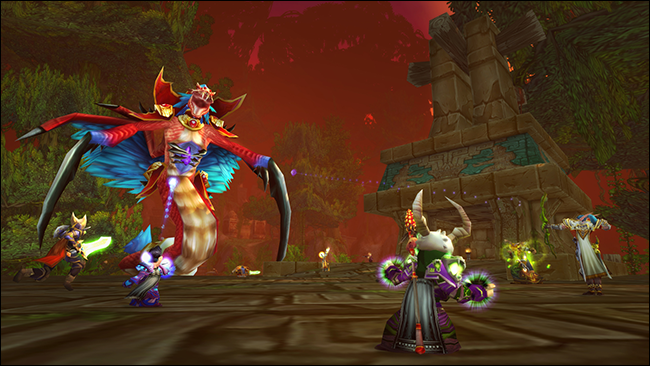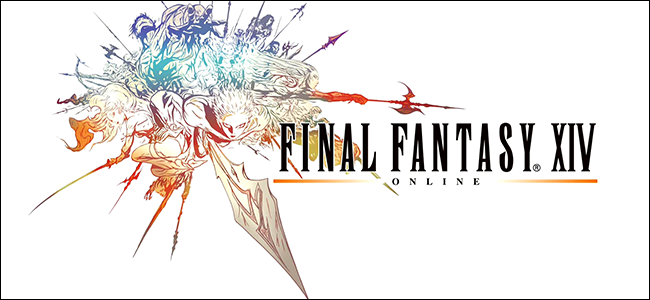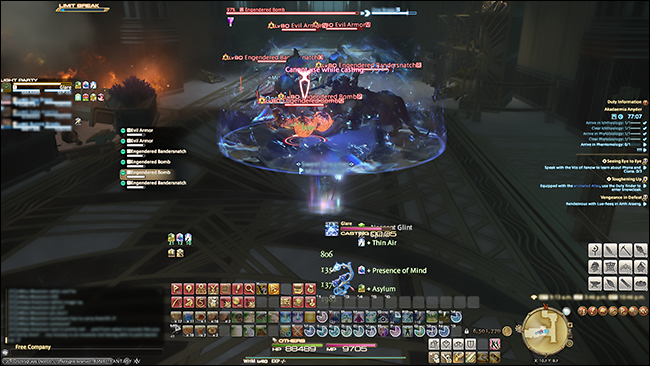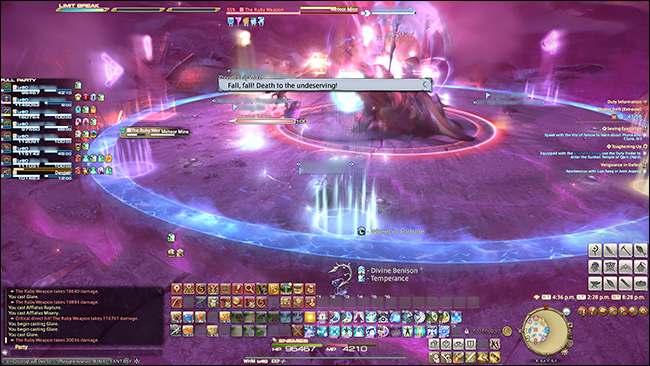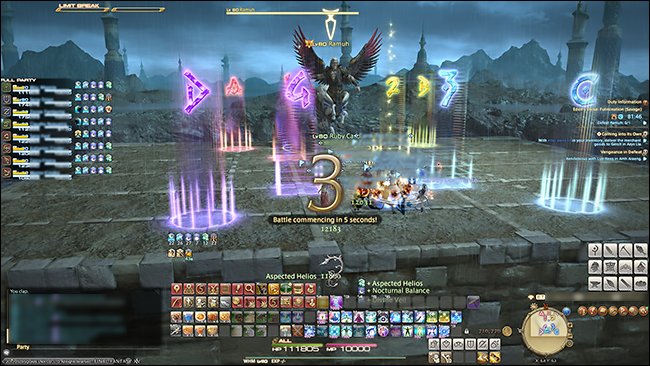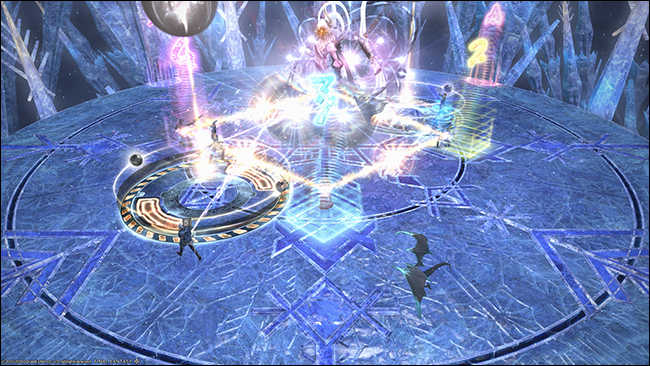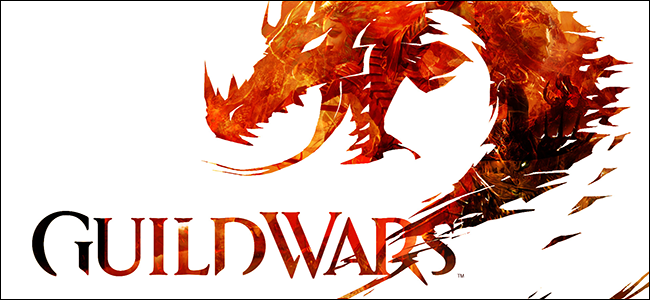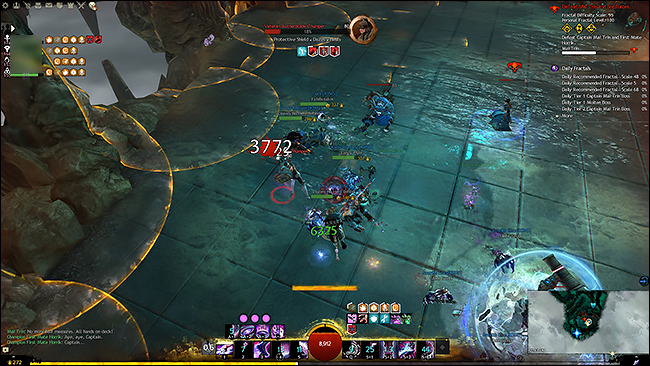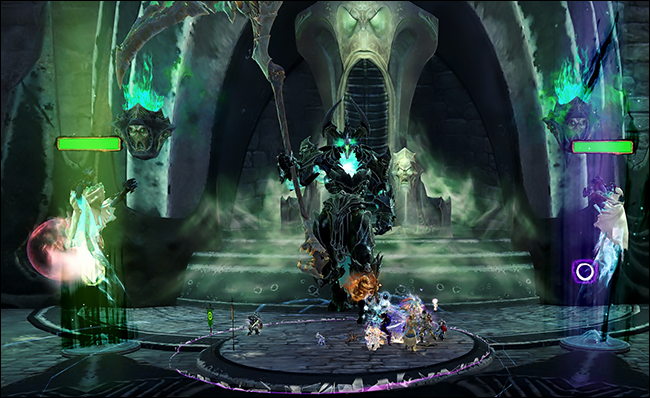Quick Links
Raiding is a core feature in massively multiplayer online RPGs. They are a fun way to interact with friends (or random players) to complete objectives and obtain rare loot drops. At higher levels, raids can be among the most challenging activities in MMOs.
What Is a Raid in an MMORPG?
In massively multiplayer online role-playing video games (MMORPGs), "raiding" is designed to only be completed by a large group of players working cooperatively. Dungeons and raids offer battle experience to level up your character and numerous other in-game rewards, from higher-level equipment to exclusive visual skins and in-game achievements.
In short: Raids form an important part of the "end game" of massively multiplayer online games, giving high-level players challenging content designed for cooperative play in groups.
Dungeons and raids usually occur within "instances": special, isolated zones within the game for only you and your group. Unlike the "open world" (where all players can interact), instances are able to support enemies with strictly scripted sequences and effects, with each stage of the instance often building on the previous one and increasing in difficulty. Once an instance is "cleared," all relevant enemies have been defeated, the rewards can be obtained. Instances are also something that players are always free to avoid; no player is forced to participate in raid progression!
Raids are instances with exceptionally difficult bosses. All raids have different mechanics (scripted behaviors that occur in response to player action, such as damaging the boss to a certain health percentage), that are designed to be more difficult as players progress through the content. Raids are intended to be the most difficult challenges to overcome in MMOs, and teams could take days or even months to conquer the mechanics and complete the raid. There's never a guarantee players will succeed, and some raids throughout history have only been cleared by a handful of players in the world.
Raids Get Progressively More Difficult
Games with raids often divide their systems into three general categories, which we call tiers here:
- Tier One content offers limited rewards and is designed to be accessible to players who are very new to raiding, or perhaps even new to the game itself.
- Tier Two content offers much better (and exclusive) rewards but requires higher group coordination and player skill. Hard difficulty content also often includes some form of progression system, wherein lower level content must be completed before higher levels may be attempted.
- Tier Three content is meant to be the ultimate challenge within an MMO. Only the highest skilled and most experienced players will be able to complete this content, and only with the help of a similarly skilled and coordinated group of players. This content offers the best rewards, many of which are exclusive cosmetic items and mechanisms for players to flaunt their skill.
Players who are new to raiding will usually begin at tier one. Those who choose to practice, improve, and progress through the lower tiers can find themselves tackling ever-harder challenges at higher tiers and reaping the ultimate rewards.
To demonstrate the concept, we'll explain how raid work in three MMORPGs: World of Warcraft, Final Fantasy XIV, and Guild Wars 2
What Is a Raid in World of Warcraft?
World of Warcraft was first released in 2004 and is the oldest MMO of the three, and raids have been part of World of Warcraft since its launch.
All dungeons and raids in World of Warcraft will have numerous normal enemies (known as "mobs") and bosses to defeat. Raids are optional end-game content for high-level players, while dungeons are meant for all players of any skill level.
To progress from one raid to another, you must first unlock the required gear. To receive better gear, you must first complete quests and normal dungeons to obtain gear that will let you into heroic dungeons, the LFR (Looking For Raid) system, and so on.
Normal Dungeons and Raids
Raids in World of Warcraft always require at least 10 players, and they are split into four difficulties: LFR (Looking For Raid), normal, heroic, and mythic. LFR and normal dungeons fall into the tier one category.
LFR is for players who want to experience the story of raid content without effort; it is meant for casual players and the odds of failure are relatively low. Normal dungeons are the starting point for those who want to begin raiding, and they are also easy to complete.
Dungeons always require five players, and there are four difficulties: normal, heroic, mythic, and mythic plus (often referred to as "Mythic+"). Normal dungeons in World of Warcraft fall into the tier one category because they are easier to complete.
Heroic and Mythic+
Higher difficulty means more health and damage generally, and so choosing a higher difficulty setting falls into the tier two category. To compete in mythic raids, you must first complete heroic raids and obtain better gear. Mythic+ can fall into tier two or tier three depending upon the difficulty on the dungeon that is chosen.
Mythic+ is a five-player timed instance that adds increased difficulty from heroic mode. The mythic+ system is exclusive to dungeons, and enemies in mythic+ dungeons deal more damage and have higher health pools with each level conquered. At certain levels, the dungeon gains an "affix" that changes the way enemies will act, adding additional complexity to the content. Mythic+ can only be unlocked by first receiving a keystone item from the previous level of difficulty (mythic).
Mythic+ doesn't have an increase in difficulty mechanically, but because it is more punishing and demanding than mythic content, mythic+ falls into the tier two category outlined at the beginning of this article. Mythic+ endlessly scales higher, so the higher tier challenges could fall into the tier three category.
Mythic Raids
Mythic raiding, the hardest difficulty in World of Warcraft, is the only raid with a fixed party size of 20 players. Mythic difficulty for raids is designed to be the most challenging instance content available, and it offers the highest level gear and exclusive rewards.
Skill increase and gear requirements are necessary if players choose to jump from heroic content into mythic. Progression races among the top teams are put on display when new mythic raids are released, and World of Warcraft is exceptionally competitive in a way that other MMOs are not, with leaderboards and rankings prominently displayed within the games different servers across the world.
What Is a Raid in Final Fantasy XIV?
Final Fantasy XIV was released in 2010, and the first raid content became available in its first expansion, Realm Reborn. To progress from one raid to another, you had to first complete tier one, and so on to progress to the next raid tier. This is known as linear progression.
After players complete tier one of raid content, they could then progress to tier two, and eventually complete that raid sequence. After the normal raids have been cleared, the savage mode of raids can be unlocked.
Normal Dungeons, Trials, and Alliance Raids
Normal dungeons, trials, and the alliance raids represent the easiest content that Final Fantasy XIV has to offer.
In Final Fantasy XIV, players follow a main story quest that will take them through a number of instances, including dungeons, trials, and alliance raids. Dungeons consist of four players and are fairly easy to complete. Players must clear foes and make their way through the dungeon to a boss. There are typically three to four bosses in a dungeon, and the time to complete a dungeon usually takes around 20-25 minutes. Dungeons will sometimes have hard modes that can be unlocked after completing the normal mode dungeon.
Trials are designed for eight players facing a singular boss (with a normal mode and sometimes an extreme mode). A normal mode trial may take as little as 5 minutes, and an extreme trial could take up to 20 minutes. Trials do not offer the best gear, instead, they offer novelty items, such as mounts and fashion for your character to wear.
Alliance raids are fought by 24 players, made up of three separate 8-player groups, against a sequence of bosses and mobs (lesser enemy spawns), similar to a dungeon, however, alliance raids take a huge chunk of time to complete---35 minutes on average. These encounters fill the gap in difficulty between the normal 8-player raids and savage content, as they have more mechanical density and require a higher degree of accuracy in execution, but are lighter and friendlier than savage mode content.
Hard Mode Dungeons and Normal Raids
Hard mode dungeons are an increased difficulty dungeon, which is why hard mode dungeons fall into the tier two category. The enemies found in their normal mode counterparts will reappear in hard mode dungeons, but the mechanics may be more complicated.
Normal raids require a progression system to unlock the next-level content; in order to progress, players must first complete the first raid, and then the second to progress to the third, and so on to progress to the next boss---this is mentioned above as linear progression.
As players progress through the bosses, they will acquire rewards that increase the power of their characters (how much damage they deal, how much health they can restore, etc.), which in turn allows them to face stronger and more challenging bosses. This form of gear-based progression is an important feature of most raiding MMOs, and Final Fantasy XIV is no exception.
Tier two content and beyond is entirely optional.
Savage and Ultimate Raids
Savage and Ultimate raids in Final Fantasy XIV represent the optional core endgame content that offers the greatest challenges and strongest rewards. Unlike dungeons or trials, savage raids limit a player to receive rewards only once per week for a period of time following their initial release (usually within the first five months).
Savage and ultimate raid content are meant for those seeking a challenge. It takes weeks, maybe even months, to learn the patterns in these fights.
There are a lot of strategies and patterns to learn in these fights, and what makes savage content stand out from the rest is the individual responsibility of each member to learn their respective role and mechanics in the fight, but a great savage raider also knows the mechanics of others, so that they can adjust to whatever random outlier during the fight.
What Is a Raid in Guild Wars 2?
Guild Wars 2 was released in 2012 with an ambitious "living story" concept, wherein the game world was intended to change over time as the story evolved. This concept formed the core of the game's ongoing player engagement, or "endgame," for around the first two years of its existence. This, combined with its fast-paced "action combat system" and flexible class roles set the game apart from much of the MMO scene.
In 2015, Guild Wars 2 introduced its first raid, Spirit Vale, with the release of the Heart of Thorns expansion pack. This release also saw a significant increase in the difficulty of content and complexity in the combat system.
Since then, the developers have continued to periodically release additional raids and fractals (smaller group, dungeon-like instances designed to challenge players), though at a significantly slower pace compared to games like Final Fantasy XIV or World of Warcraft.
Dungeons, Fractals, and Strikes
Dungeons were released when the original game launched, and have not been substantially updated in the time since. They are incredibly easy and require five players. A dungeon was meant to take a group around 45 minutes to complete, but experienced players with better gear can complete a dungeon within 10 minutes. Dungeons will have numerous weaker enemies, puzzle mechanics, and an average of three strong bosses.
Fractals are a form of raid which requires five players, and they are significantly more difficult depending upon which level is chosen. The difficulty can be chosen prior to entering, and can scale from one up to 100; 100 being the most difficult, and most fractals can be completed within 15-20 minutes. Fractals consist of enemies with an average of three bosses per instance.
Fractal content must be completed in sequential order, starting at fractal one and ascending to 100. As you progress to higher difficulty levels, the rewards for completion will also increase. The highest tiers of fractals are among the most challenging content in the game, and the rewards are also among the most substantial.
Strikes are newer lower-tier raids that require 5-10 players to complete. Strikes have been designed either as a beginner-friendly stepping-stone into raids, or perhaps a long-term replacement for raids in general. Strikes will have a single boss to kill, and can be completed within 5-10 minutes.
High-Tier Fractals
Fractals increase in difficulty from level one all the way up to level 100. The highest level fractals pose a challenge to most five-player groups. While fractals are more accessible than raids because they require fewer players, they are often more punishing in their design, requiring all five players to act without mistakes.
In Guild Wars 2, raids are 10-player instances focusing on challenging combat and mechanics, designed for max-level characters wearing the very best gear. Like dungeons and fractals, raids usually consist of three bosses with intervening encounters with weaker enemies and puzzle areas.
Because there is a significant difficulty increase, the high-tier fractals easily fall into the tier two category outlined above.
Challenge Motes
Challenge motes offer the highest difficulty for MMO raiders, so they easily fall into the tier three category of raid content. Challenge motes are designed as a system for some fractals and certain raid bosses which allow players to optionally increase the difficulty of the encounter.
With a challenge mote active, a boss will have additional health, deal extra damage to players, and layer additional mechanics onto their normal form, which often completely change the way that players must approach the encounter. Challenge motes offer some additional rewards, often in the form of cosmetic items, which players can use to demonstrate they are among the most skilled in the game.

